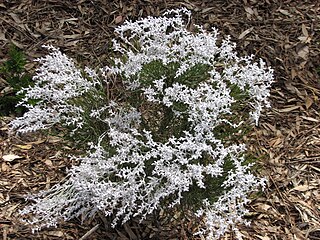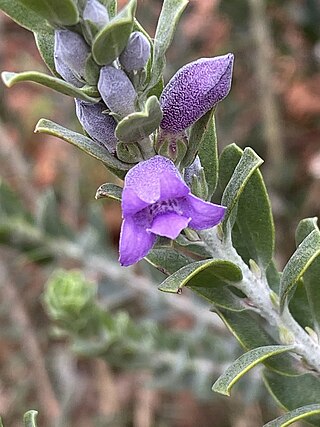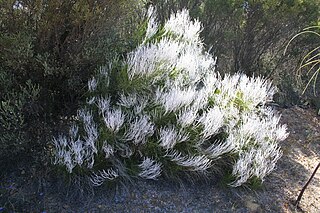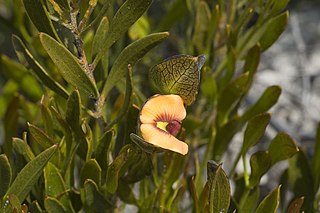
Conospermum is a genus of about 50 species of flowering plants in the family Proteaceae that are endemic to Australia. Members of the genus are known as smokebushes - from a distance, their wispy heads of blue or grey flowers resemble puffs of smoke. They have an unusual pollination method that sometimes leads to the death of visiting insects. They are found in all Australian states, though most occur only in Western Australia. Smokebushes are rarely cultivated, though the flowers of several Western Australian species are harvested for the cut flower industry.

Thryptomene is a genus of flowering plants in the family Myrtaceae and is endemic to Australia. Plants in the genus Thryptomene are shrubs with small leaves arranged in opposite pairs and white or pink flowers. About forty-seven species of Thryptomene, occurring in all Australian states and the Northern Territory, have been formally described.

Conospermum stoechadis, commonly known as common smokebush, is a shrub endemic to Western Australia.

Eremophila racemosa, also known as showy eremophila, is a flowering plant in the figwort family Scrophulariaceae, and is endemic to Western Australia. It is an erect shrub with glabrous leaves, small, green sepals and flowers that have many colour variations often changing as they age.

Grevillea integrifolia, commonly known as entire-leaved grevillea, is a species of flowering plant in the family Proteaceae and is endemic to the south-west of Western Australia. It is an erect shrub with egg-shaped leaves, the narrower end towards the base, and cylindrical clusters of white to creamy-white flowers.

Eremophila resinosa, also known as resinous eremophila, is a flowering plant in the figwort family, Scrophulariaceae and is endemic to Western Australia. It is a spreading shrub with sticky young foliage, short leaves, small sepals and mauve, purple or sometimes white flowers.

Eremophila viscida, commonly known as varnish bush, is a flowering plant in the figwort family, Scrophulariaceae and is endemic to Western Australia. It is a large shrub or small tree with large green leaves which are sticky when young, colourful sepals and greenish-white petals with red to purple markings.

Verticordia chrysantha, commonly known as yellow featherflower or yellow Morrison, is a flowering plant in the myrtle family, Myrtaceae and is endemic to Western Australia. It is a small, slow-growing, rather bushy shrub with bright yellow flowers which often turn reddish-brown as they age. It is widespread in the south-west of the state.

Verticordia grandiflora, commonly known as claw featherflower, clawed featherflower or horned featherflower, is a flowering plant in the myrtle family Myrtaceae, and is endemic to the south-west of Western Australia. It is a small, rigid shrub with many short side-branches, mostly linear leaves and heads of yellow flowers which soon age to reddish but which are among the largest in the genus. It is similar in appearance to several other species of verticordias with which it is often confused.

Verticordia roei, commonly known as Roe's featherflower is a flowering plant in the myrtle family, Myrtaceae and is endemic to the south-west of Western Australia. It is a shrub with narrow leaves and is often covered with masses of creamy-white coloured flowers in late spring.

Darwinia purpurea, commonly known as the rose darwinia, is a species of flowering plant in the family Myrtaceae and is endemic to the southwest of Western Australia. It is a spreading shrub with linear leaves and dense heads of red or yellow flowers surrounded by many overlapping involucral bracts.

Pileanthus peduncularis, commonly known as coppercups, is a plant species of the family Myrtaceae endemic to Western Australia.

Thryptomene australis, commonly known as hook-leaf thryptomene, is a species of flowering plant in the family Myrtaceae and is endemic to the south-west of Western Australia. It is an erect, bushy and spreading shrub with upward-pointing leaves with the tip curving outwards, and flowers with white petals arranged spike-like near the ends of the branchlets.

Conospermum crassinervium, commonly known as the summer smokebush or tassel smokebush, is a shrub endemic to Western Australia.
Conospermum eatoniae, commonly known as blue lace, is a shrub endemic to Western Australia.

Conospermum triplinervium, commonly known as the tree smokebush or elk smokebush, is a tree or shrub endemic to Western Australia.

Trachymene ornata, or spongefruit, is a slender annual herb in the family Araliaceae. It is native to Australia and found in Western Australia, South Australia and New South Wales.

Dicrastylis corymbosa is a species of plant within the genus, Dicrastylis, in the family Lamiaceae. It is endemic to Western Australia.

Daviesia alternifolia is a species of flowering plant in the family Fabaceae and is endemic to the south-west of Western Australia. It is a dense, spreading shrub with scattered, egg-shaped phyllodes with the narrower end towards the base, and orange and red flowers with a greenish-yellow centre.

Daviesia oppositifolia, commonly known as rattle-pea, is a species of flowering plant in the family Fabaceae and is endemic to the south-west of Western Australia. It is an erect shrub with many stems, egg-shaped phyllodes with the narrower end towards the base, and yellow flowers with maroon markings.



















